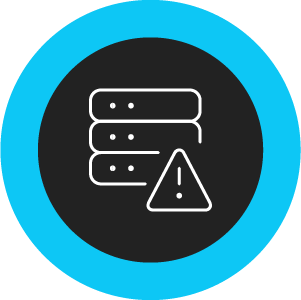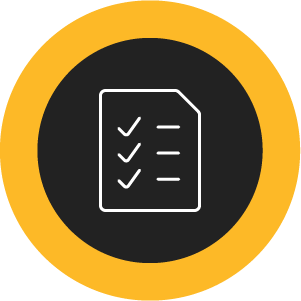Manufacturers rely heavily on digital assets, from nameplates and QR codes to product images and documentation. With potentially millions of assets in play, a digital asset management (DAM) program is often a game-changer. Unfortunately, misaligned software or processes can set you back.
Are you feeling pain from a DAM program that’s failing to thrive? Here are six common digital asset management pitfalls and what you can do to avoid them.

DAM challenge #1: Clunky, chaotic workflows
Assets should move effortlessly across a business, from creation to sharing. But what if clunky workflows make it hard for marketing, sales, and others to access what they need?
Consider an industrial manufacturer’s need for trackability. If a motor breaks down in your customer’s factory, a sales rep must swiftly find assets, such as instruction manuals or replacement part images, to save the day. Without them, production could stop—meaning big cost to the company.
Business users understand these struggles but the requirements can get lost in translation with the IT teams that build and manage the systems. This divide leads to messy workflows. Once that happens, it’s tough to untangle the mess.

DAM challenge #2: Always on the hunt
Ever had a digital asset you can’t locate? You’re not alone. DAM software search functionality often falls short, inundating users with a flood of results that they still have to manually sift through. Finding a digital asset should take minutes but it ends up taking hours. Your system can get bogged down with “orphaned” assets—which are centralized yet unused. What good is an asset if it’s lost in the digital abyss?

DAM challenge #3: Outdated, over-customized, unsupported tech
The challenge of handling outdated DAM programs is real. The infrastructure investments for digital asset management are often deprioritized. Over time, IT teams add various “fixes” to older, legacy systems to solve new problems. Your teams do the best they can to make them work. But these one-off customizations eventually make your DAM software more cumbersome to use and nearly impossible to upgrade.
Older tools usually run on servers, missing out on cloud-based updates. Servers require heavy maintenance and typically have stability problems. Companies using these DAM solutions know they need change, but making improvements without breaking your current systems is tricky and requires continuous prioritization.

DAM challenge #4: Low user adoption
If your teams are accustomed to clunky workflows, poor search, and broken processes, they won’t be excited to adopt a new set of processes. You have to prove to them that it’s different this time. And that a standardized DAM system provides what you’ve been missing: consistency and efficiency.
But in many cases, as the company evolves and the DAM system stops fitting certain needs, people stop using it altogether. This paves the way for teams to create new workarounds that worsen existing silos. In some instances, entire business units might resist engagement due to the sluggishness of your current DAM software setup.

DAM challenge #5: Losing track of digital rights management
Navigating the ins and outs of digital rights management is a major undertaking, especially for product manufacturers. Imagine a hero image on your CPG website featuring a happy baby in diapers—but the model’s contract lasts exactly two years. This one image could live in 30 different spots across your digital ecosystem. When that contract ends, it’s important that you can find each image, time the removals, and seamlessly replace the image everywhere it appears.
Many companies struggle to manage the details of photography rights. Processes are often disjointed, technology falls short, and some users might not understand why metadata for each image is so important. Regardless, businesses that don’t have a robust system and strategy for rights management can face fines and legal woes.

DAM challenge #6: Resource constraints
All this complexity means that companies need better support. Yet for many businesses, DAM presents uncharted territory and nuances that remain unaddressed.
For example, because DAM plays a niche role in your tech stack, there may be a wider knowledge gap requiring change management. You must educate people throughout the company about what DAM is, why it’s important to their role, and how they can contribute to its success.
You may also need to introduce new roles, such as a “DAM librarian.” Much like a traditional librarian is to books, a DAM librarian is to digital assets. They’re responsible for efficiently organizing and curating your asset repository. They ensure each asset is correctly tagged with metadata, making it easily searchable and accessible to the appropriate teams.
Find the root cause of DAM issues
Without the right resources and strategy, getting on track with DAM often feels like an uphill battle. There are many things that can go wrong and get in the way of your success.
When that happens, instead of creating another temporary fix, I want you to become a DAM detective. Dig deeper to find the core issues and identify their root causes.
Remember that every aspect of your DAM strategy involves people, processes, and technology. So, if you’re encountering hitches, it’s often tied to one or more of these components:
- User experience of the DAM system
- Current technology you’re using as a DAM
- Asset lifecycle/workflow of your digital assets
For instance, let’s say your team members are avoiding using the tool. Assets go missing, inaccurate data sheets are showing up in the wild, and image rights contracts are getting overlooked. You might blame the software, but the real issue could be an exhausting 100-field form. Users don’t want to scroll for days – and they don’t have time to make your current processes work. Instead, they find a workaround or move on with their busy day.
Striking a balance between user ease and business requirements is key. It’s like solving a puzzle — and doing so is how you address any pain points to create an effective DAM strategy.
Take action on your DAM challenges
Feeling hopeful about solving your DAM issues but a bit overwhelmed? Don’t worry, we’ve got your back. Here are three steps that can help you tackle the task with confidence.

1: Perform an audit
Begin with a thorough assessment of your current state and processes. Enlist the expertise of DAM consultants to delve into why user adoption is lagging. What are the barriers to entry? How’s your classification and cataloging process? What’s within your control, and what isn’t? After an audit, we can help you find and apply DAM best practices to make your DAM program easier and more effective.

2: Upgrade to cloud-based software
Take a closer look at whether your technology is fit for its purpose. If not, we can help you evaluate your requirements, explore platform options, and guide you on the ideal choice. We can also show you how integrating product data and DAM can boost your results.

3: Prioritize ongoing governance
Processes tend to unravel over time. You can set everything up perfectly, but without the right governance processes in place, it will gradually fall apart.
To maintain the ordered environment your users need to adopt DAM systems and processes, communication is key. Facilitate dialogue across different areas of your business to keep your practice organized and well-structured.
Think through change management: How will you ensure that everyone who should use your DAM knows what they need to do? One powerful solution is establishing a digital asset governance committee.
Instead of relying solely on one team (like IT) to make decisions, this committee brings together representatives from your various business disciplines together. Think DAM librarians, IT, marketing, legal, ecommerce, SEO, sales, warehousing, packaging, administration, ERP, downstream, regulatory, and more.
DAM made easy: Partner with Ntara
At Ntara, we’re passionate about helping industrial manufacturers and consumer brands maximize their digital asset potential. Our consultants understand the nuances of designing a unified data practice (i.e., infrastructure + process) aligned to your exact needs.
Interested in learning more from our DAM experts?
Let’s talk. Fill out the form to discuss DAM with a member of our team today.